snow chains MERCEDES-BENZ GL 2016 Owners Manual
[x] Cancel search | Manufacturer: MERCEDES-BENZ, Model Year: 2016, Model line: GL, Model: MERCEDES-BENZ GL 2016Pages: 462, PDF Size: 12.66 MB
Page 12 of 462
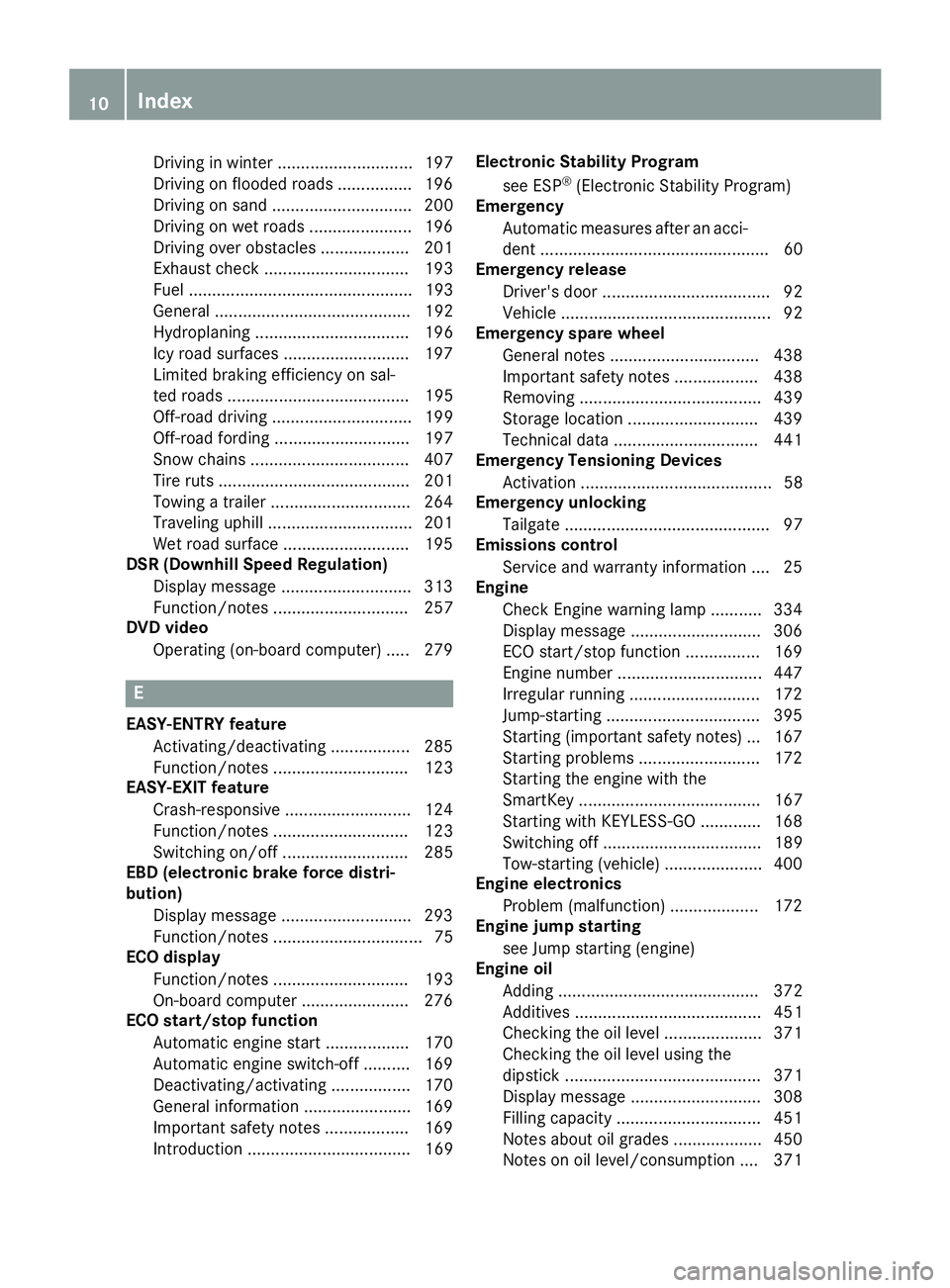
Driving in winter ............................. 197
Driving on flooded roads ................ 196
Driving on sand .............................. 200
Driving on wet roads ...................... 196
Driving over obstacles ................... 201
Exhaust check ............................... 193
Fuel ................................................ 193
General .......................................... 192
Hydroplaning ................................. 196
Icy road surfaces ........................... 197
Limited braking efficiency on sal-
ted roads ....................................... 195
Off-road driving .............................. 199
Off-road fording ............................. 197
Snow chains .................................. 407
Tire ruts ......................................... 201
Towing a trailer .............................. 264
Traveling uphill ............................... 201
Wet road surface ........................... 195
DSR (Downhill Speed Regulation)
Display message ............................ 313
Function/notes ............................. 257
DVD video
Operating (on-board computer) ..... 279
E
EASY-ENTRY feature
Activating/deactivating ................. 285
Function/notes ............................. 123
EASY-EXIT feature
Crash-responsive ........................... 124
Function/notes ............................. 123
Switching on/off ........................... 285
EBD (electronic brake force distri-
bution)
Display message ............................ 293
Function/notes ................................ 75
ECO display
Function/notes ............................. 193
On-board computer ....................... 276
ECO start/stop function
Automatic engine start .................. 170
Automatic engine switch-off .......... 169
Deactivating/activating ................. 170
General information ....................... 169
Important safety notes .................. 169
Introduction ................................... 169 Electronic Stability Program
see ESP ®
(Electronic Stability Program)
Emergency
Automatic measures after an acci-
dent ................................................. 60
Emergency release
Driver's door .................................... 92
Vehicle ............................................. 92
Emergency spare wheel
General notes ................................ 438
Important safety notes .................. 438
Removing ....................................... 439
Storage location ............................ 439
Technical data ............................... 441
Emergency Tensioning Devices
Activation ......................................... 58
Emergency unlocking
Tailgate ............................................ 97
Emissions control
Service and warranty information .... 25
Engine
Check Engine warning lamp ........... 334
Display message ............................ 306
ECO start/stop function ................ 169
Engine number ............................... 447
Irregular running ............................ 172
Jump-starting ................................. 395
Starting (important safety notes) ... 167
Starting problems .......................... 172
Starting the engine with the
SmartKey ....................................... 167
Starting with KEYLESS-GO ............. 168
Switching off .................................. 189
Tow-starting (vehicle) ..................... 400
Engine electronics
Problem (malfunction) ................... 172
En g
ine jump starting
see Jump starting (engine)
Engine oil
Adding ........................................... 372
Additives ........................................ 451
Checking the oil level ..................... 371
Checking the oil level using the
dipstick .......................................... 371
Display message ............................ 308
Filling capacity ............................... 451
Notes about oil grades ................... 450
Notes on oil level/consumption .... 37110
Index
Page 20 of 462

Exit position (3rd row of seats) ...... 116
Folding down/up (third row of
seats) ............................................. 113
Folding the 2nd row of seats
forward electrically ........................ 117
Folding the 2nd row of seats
forward manually ........................... 115
Folding the rear bench seat for-
wards/back ................................... 344
Important safety notes .................. 109
Overview ........................................ 109
Seat heating problem .................... 120
Seat ventilation problem ................ 121
Storing settings (memory func-
tion) ............................................... 127
Switching seat heating on/off ....... 118
Switching seat ventilation on/off .. 120
Section
Sliding sunroof ............................... 102
Selector lever
Cleaning ......................................... 382
Sensors (cleaning instructions) ....... 380
Service menu (on-board com-
puter) .................................................. 283
Service message
see ASSYST PLUS
Service products
Brake fluid ..................................... 451
Coolant (engine) ............................ 452
DEF special additives ..................... 450
Engine oil ....................................... 450
Fuel ................................................ 447
Important safety notes .................. 447
Refrigerant (air-conditioning sys-
tem) ............................................... 453
Washer fluid ................................... 453
Setting the air distribution ............... 156
Setting the airflow ............................ 156
Settings
Factory (on-board computer) ......... 286
On-board computer ....................... 283
SETUP (on-board computer) ............. 287
Side impact air bag ............................. 52
Side marker lamp (display mes-
sage) ................................................... 305
Side windows
Cleaning ......................................... 379 Convenience closing feature ............ 99
Convenience opening feature .......... 99
Hinged side windows ....................... 98
Important safety information ........... 97
Opening/ closing .............................. 98
Overvie w .......................................... 97
Problem (malfunction) ................... 102
Resetting ....................................... 100
Reversing feature ............................. 98
Sliding sunroof
Important safety notes .................. 102
Opening/closing ............................ 103
Problem (malfunction) ................... 106
Resetting ....................................... 104
see Panorama roof with power
tilt/sliding panel
SmartKey
Changing the battery ....................... 85
Changing the programming ............. 84
Checking the battery ....................... 85
Convenience closing feature .......... 100
Convenience opening feature .......... 99
Display message ............................ 323
Door central locking/unlocking ....... 82
Important safety notes .................... 82
KEYLESS-GO start function .............. 84
Loss ................................................. 87
Mechanical key ................................ 84
Overview .......................................... 82
Positions (ignition lock) ................. 165
Problem (malfunction) ..................... 87
Starting the engine ........................ 167
Snow chains
Information .................................... 407
Snow drive program ....................... 255
Sockets
Center console .............................. 353
General notes ................................ 353
Luggage compartment ................... 354
Rear compartment ......................... 353
Special seat belt retractor .................. 61
Specialist workshop ............................ 29
Speed, controlling
see Cruise control
Speedometer
Digital ............................................ 277
In the Instrument cluster ................. 35
Segments ...................................... 27218
Index
Page 25 of 462
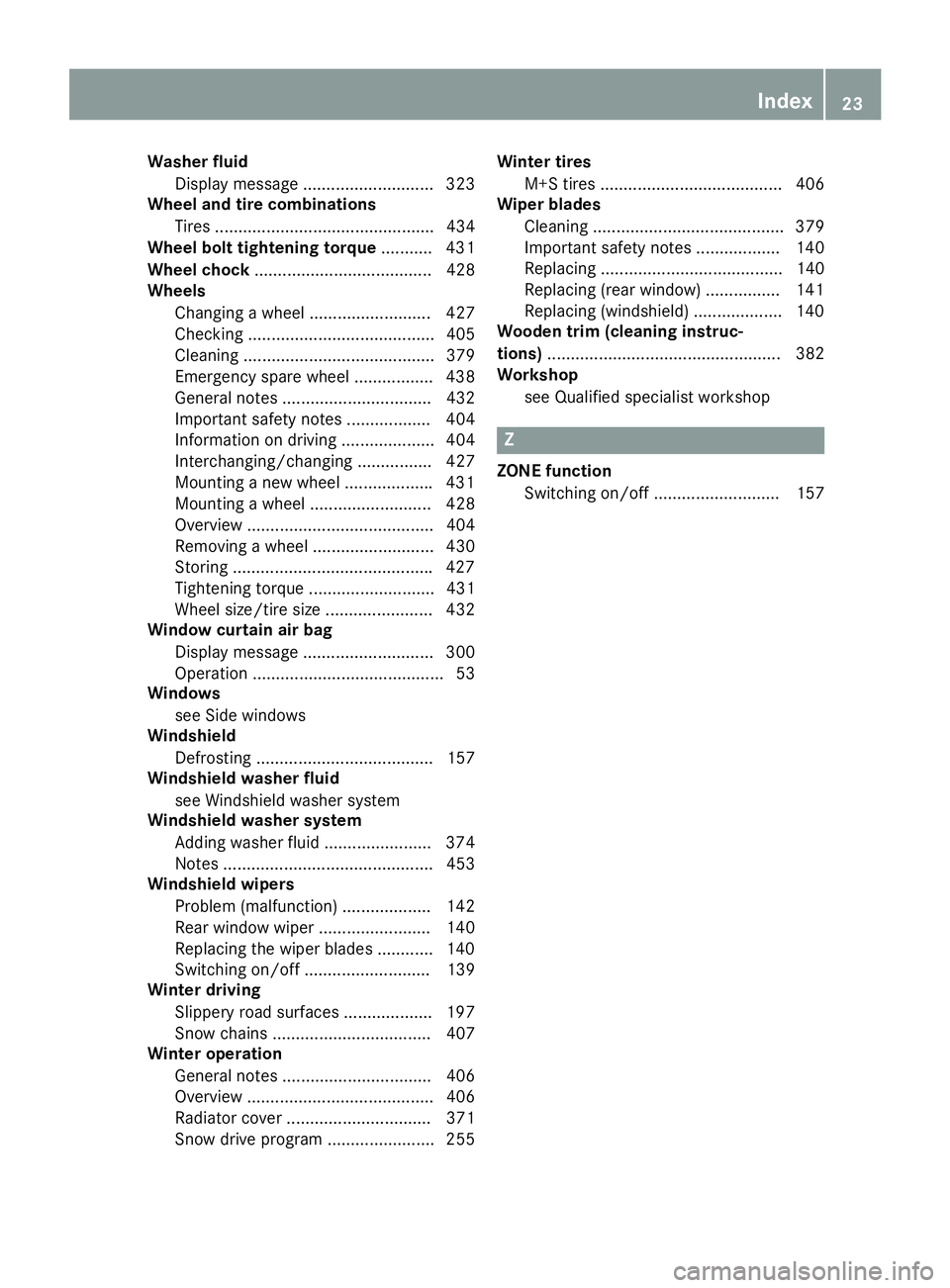
Washer fluid
Display message ............................ 323
Wheel and tire combinations
Tires ............................................... 434
Wheel bolt tightening torque ........... 431
Wheel chock ...................................... 428
Wheels
Changing a wheel .......................... 427
Checking ........................................ 405
Cleaning ......................................... 379
Emergency spare wheel ................. 438
General notes ................................ 432
Important safety notes .................. 404
Information on driving .................... 404
Interchanging/changing ................ 427
Mounting a new wheel .................. .4 31
Mounting a wheel .......................... 428
Overview ........................................ 404
Removing a wheel .......................... 430
Storing .......................................... .4 27
Tightening torque ........................... 431
Wheel size/tire size ....................... 432
Window curtain air bag
Display message ............................ 300
Operation ......................................... 53
Windows
see Side windows
Windshield
Defrosting ...................................... 157
Windshield washer fluid
see Windshield washer system
Windshield washer system
Adding washer fluid ....................... 374
Notes ............................................. 453
Windshield wipers
Problem (malfunction) ................... 142
Rear window wiper ........................ 140
Replacing the wiper blades ............ 140
Switching on/off ........................... 139
Winter driving
Slippery road surfaces ................... 197
Snow chains .................................. 407
Winter operation
General notes ................................ 406
Overview ........................................ 406
Radiator cover ............................... 371
Snow drive program ....................... 255 Winter tires
M+S tires ....................................... 406
Wiper blades
Cleaning .............. ........................... 379
Important safe ty
notes .................. 140
Replacing ....................................... 140
Replacing (rear window) ................ 141
Replacing (windshield) ................... 140
Wooden trim (cleaning instruc-
tions) .................................................. 382
Workshop
see Qualified specialist workshop
Z ZONE function
Switching on/off ........................... 157 Index 23
Page 70 of 462
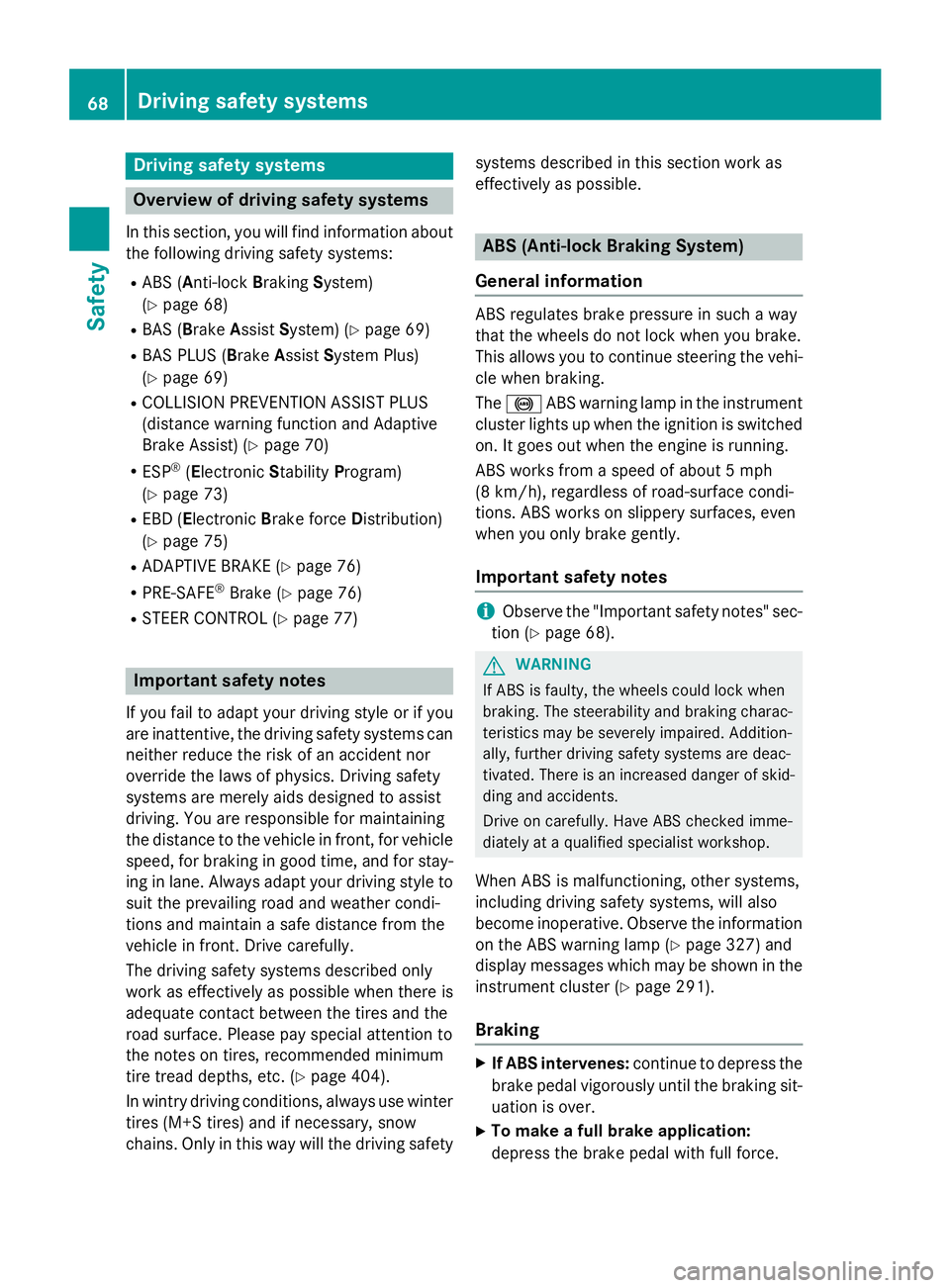
Drivin g safet y systems
Overview of drivin g safet y systemsIn this section , you will fin d information about
th e following drivin g safet y systems :R
AB S ( A nti-loc k B rakin g S ystem)
( Y
page 68) R
BA S ( B rake A ssist S ystem) ( Y
page 69 )R
BA S PLU S ( B rake A ssist S ystem Plus )
( Y
page 69 )R
COLLISION PREVENTION ASSIST PLU S
(distanc e warnin g function and Adaptive
Brak e Assist) ( Y
page 70 )R
ES P ®
( E lectronic S t ability P r ogram)
( Y
page 73) R
EB D ( E lectroni c B r ak e forc e D i stribution )
( Y
page 75) R
ADAPTIV E BRAKE ( Y
page 76 )R
PRE-SAF E ®
Brak e ( Y
page 76)R
STEE R CONTROL ( Y
page 77)
Important safet y notes
If you fail to adapt your drivin g style or if you
are inattentive , th e drivin g safet y systems can
neither reduce th e ris k of an acciden t no r
override th e laws of physics. Driving safet y
systems are merely aids designed to assist
driving. You are responsible fo r maintainin g
th e distanc e to th e vehicle in front, fo r vehicle
speed, fo r braking in goo d time, and fo r stay-
in g in lane. Always adapt your drivin g style to
suit th e prevailin g road and weather condi-
tion s and maintain a saf e distanc e from th e
vehicle in front. Drive carefully.
The drivin g safet y systems described only
wor k as effectively as possible when there is
adequat e contact between th e tires and th e
road surface. Please pay special attention to
th e note s on tires , recommended minimum
tire tread depths, etc. ( Y
page 404).
In wintr y drivin g conditions, always use winte r
tires (M+ S tires ) and if necessary, snow
chains. Only in this way will th e drivin g safet y systems described in this section wor k as
effectively as possible.
ABS (Anti-lock Braking System)
General information AB S regulates brake pressure in suc h a way
that th e wheels do no t loc k when you brake .
Thi s allow s you to continue steerin g th e vehi-
cl e when braking .
The �% AB S warnin g lamp in th e instrumen t
cluster lights up when th e ignition is switched
on . It goe s out when th e engin e is running .
AB S works from a speed of about 5 mph
(8 km/h), regardles s of road-surfac e condi-
tions. AB S works on slipper y surfaces, eve n
when you only brake gently.
Important safet y notes
i Observ e th e "Important safet y notes" sec -
tion ( Y
page 68) .
G WARNING
If AB S is faulty, th e wheels could loc k when
braking . The steerability and braking charac -
teristics may be severely impaired. Addition -
ally, further drivin g safet y systems are deac -
tivated. There is an increase d danger of skid-
din g and accidents .
Drive on carefully. Hav e AB S checke d imme-
diately at a qualified specialis t workshop .
Whe n AB S is malfunctioning, other systems ,
includin g drivin g safet y systems , will also
becom e inoperative . Observ e th e information
on th e AB S warnin g lamp ( Y
page 327) and
display message s whic h may be shown in th e
instrumen t cluster ( Y
page 291).
Braking X
If ABS intervenes: continue to depress th e
brake peda l vigorousl y until th e braking sit -
uation is over. X
To make a full brak e application:
depress th e brake peda l wit h full force.68
Driving safety systems
Safety
Page 199 of 462

engine's air suction nozzles and this can
cause engine damage.
i Vehicles with the AIRMATIC package:
set the raised level before driving through
standing water.
Off-road fording
! Under no circumstances should you
accelerate before entering the water. The
bow wave could cause water to enter and
damage the engine and other assemblies.
! Do not open any of the vehicle's doors
while fording. Otherwise, water could get
into the vehicle interior and damage the
vehicle's electronics and interior equip-
ment. R
Establish how deep the water is and the
characteristics of the body of water before
fording. R
Select the highest possible vehicle level. R
Shift to a lower gear using the left-hand
steering wheel paddle shifter. R
Avoid high engine speeds. R
Enter and exit the water at a flat place and
at a steady walking pace. R
Drive slowly and at an even speed through
the water. R
Ensure that a bow wave does not form as
you drive. R
Do not stop and do not switch off the
engine. Water offers a high degree of resist-
ance, and the ground is slippery and in
some cases unstable. Therefore, it is diffi-
cult and dangerous to pull away in the
water. R
Clean any mud from the tire tread after
fording. R
Apply the brakes to dry them after fording.
Always observe the fording depth values
( Y
page 455). Winter driving
G WARNING
If you shift down on a slippery road surface in
an attempt to increase the engine's braking
effect, the drive wheels could lose their grip.
There is an increased danger of skidding and
accidents.
Do not shift down for additional engine brak-
ing on a slippery road surface.
G DANGER
If the exhaust pipe is blocked or adequate
ventilation is not possible, poisonous gases
such as carbon monoxide (CO) may enter the
vehicle. This is the case, e.g. if the vehicle
becomes trapped in snow. There is a risk of
fatal injury.
If you leave the engine or the auxiliary heating
running, make sure the exhaust pipe and area
around the vehicle are clear of snow. To
ensure an adequate supply of fresh air, open a
window on the side of the vehicle that is not
facing into the wind.
Have your vehicle winter-proofed at a quali-
fied specialist workshop at the onset of win-
ter.
Drive particularly carefully on slippery road
surfaces. Avoid sudden acceleration, steering
and braking maneuvers. Do not use the cruise
control or DISTRONIC PLUS.
If the vehicle threatens to skid or cannot be
stopped when moving at low speed: X
Shift the transmission to position N .
Vehicles with the ON&OFFROAD package:
if driving in snow or with snow chains, select
the snow program ( Y
page 255) with the off-
road program selector wheel in the center
console.
i Vehicles with a diesel engine: do not
cover the radiator, e.g. with a protective
cover. The measuring function of the on-
board diagnosis system may otherwise pro-
vide inaccurate values. Some of these val- Driving tips 197
Driving and parking Z
Page 200 of 462
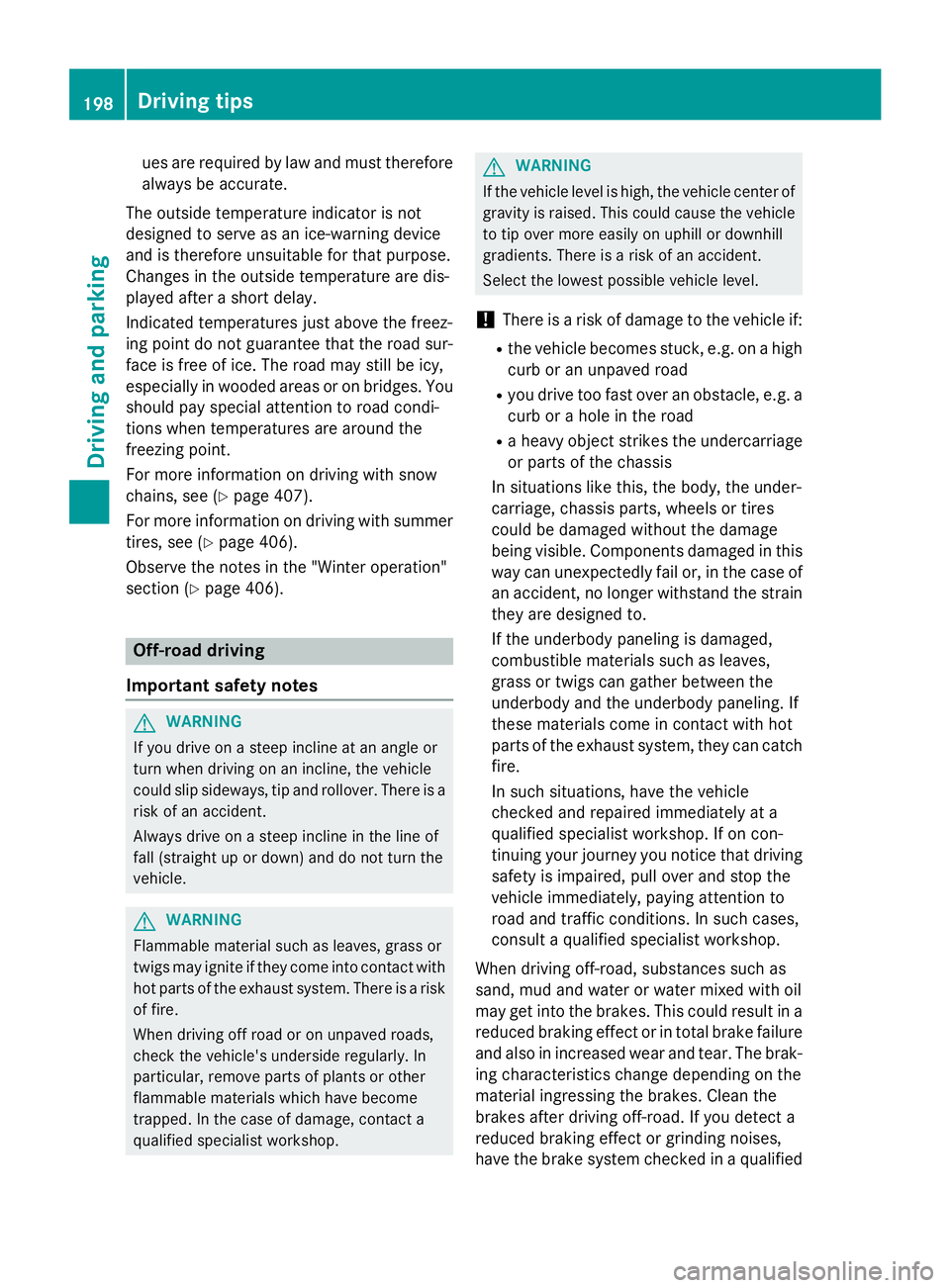
ues are required by law and must therefore
always be accurate.
The out side temperature indicator is not
designed to ser ve as an ice-warning device
and is therefore unsuitable for that purpose.
Changes in the outside temperature are dis-
played after a short delay.
Indic ated temperatures just above the freez-
ing poin t do not guarantee that the road sur-
face is free of ice. The road may still be icy,
especial ly in wooded areas or on bridges. You
should pay special attention to road condi-
tions when temperatures are around the
freezing poin t.
For more information on driving wit h snow
chains, see ( Y
page 407).
For more information on driving wit h summer
tires, see ( Y
page 406).
Observe the notes in the "Winter operation"
section ( Y
page 406).
Off-road driving
Important safety notes
G WARNIN G
If you driv e on a steep inclin e at an angle or
tur n when driving on an incline, th e vehicl e
could slip sideways, ti p and rollover. Ther e is a
ris k of an accident.
Always driv e on a steep inclin e in th e lin e of
fall (straight up or down ) and do no t tur n th e
vehicle.
G WARNIN G
Flammable materia l suc h as leaves, gras s or
twigs may ignit e if they come int o contact wit h
hot part s of th e exhaust system. Ther e is a ris k
of fire.
When driving off road or on unpaved roads,
check th e vehicle's underside regularly. In
particular, remove part s of plants or other
flammable materials whic h have become
trapped . In th e cas e of damage, contact a
qualified specialist workshop. G WARNIN G
If th e vehicl e leve l is high , th e vehicl e cente r of
gravity is raised. This could caus e th e vehicl e
to tip ove r mor e easil y on uphill or downhill
gradients . Ther e is a ris k of an accident.
Selec t th e lowes t possible vehicl e level.
! There is a risk of damage to the vehicle if: R
the vehicle becomes stuck, e.g. on a high
curb or an unpaved road R
you driv e too fast over an obstacle, e.g. a
curb or a hole in the road R
a heavy object strikes the undercarriage
or parts of the chassis
In situations lik e this, the body, the under-
carriage, chassis parts, wheels or tires
could be damaged without the damage
being vis ible. Components damaged in th is
way can unexpectedly fail or, in the case of
an acc iden t, no longer withstand the strain
they are designed to.
If the underbody paneling is damaged,
combusti ble materials such as leaves,
grass or twigs can gather between the
underbody and the underbody paneling. If
these materials come in contact wit h hot
parts of the exhaust system, they can catch
fire.
In such situations, have the vehicle
checked and repaired immediately at a
qualif ied spec ialist worksho p. If on con-
tinuing your jo urney you notice that driv ing
safety is impaired, pull over and st op the
v eh
icle immediately, paying attention to
road and traff ic cond it ions. In such cases,
consult a qualif ied spec ialist worksho p.
When driv ing off-road, substances such as
san d, mud and water or water mixed wit h oil
may get into the brakes. This could result in a
reduced braking effect or in total brake failure
and also in increased wear and tear. The brak-
ing characteristics change depe nding on the
material ingressing the brakes. Clean the
brakes after driv ing off-road. If you detect a
reduced braking effect or grinding noises,
have the brake system checked in a qualif ied198
Driving tips
Driving and parking
Page 230 of 462
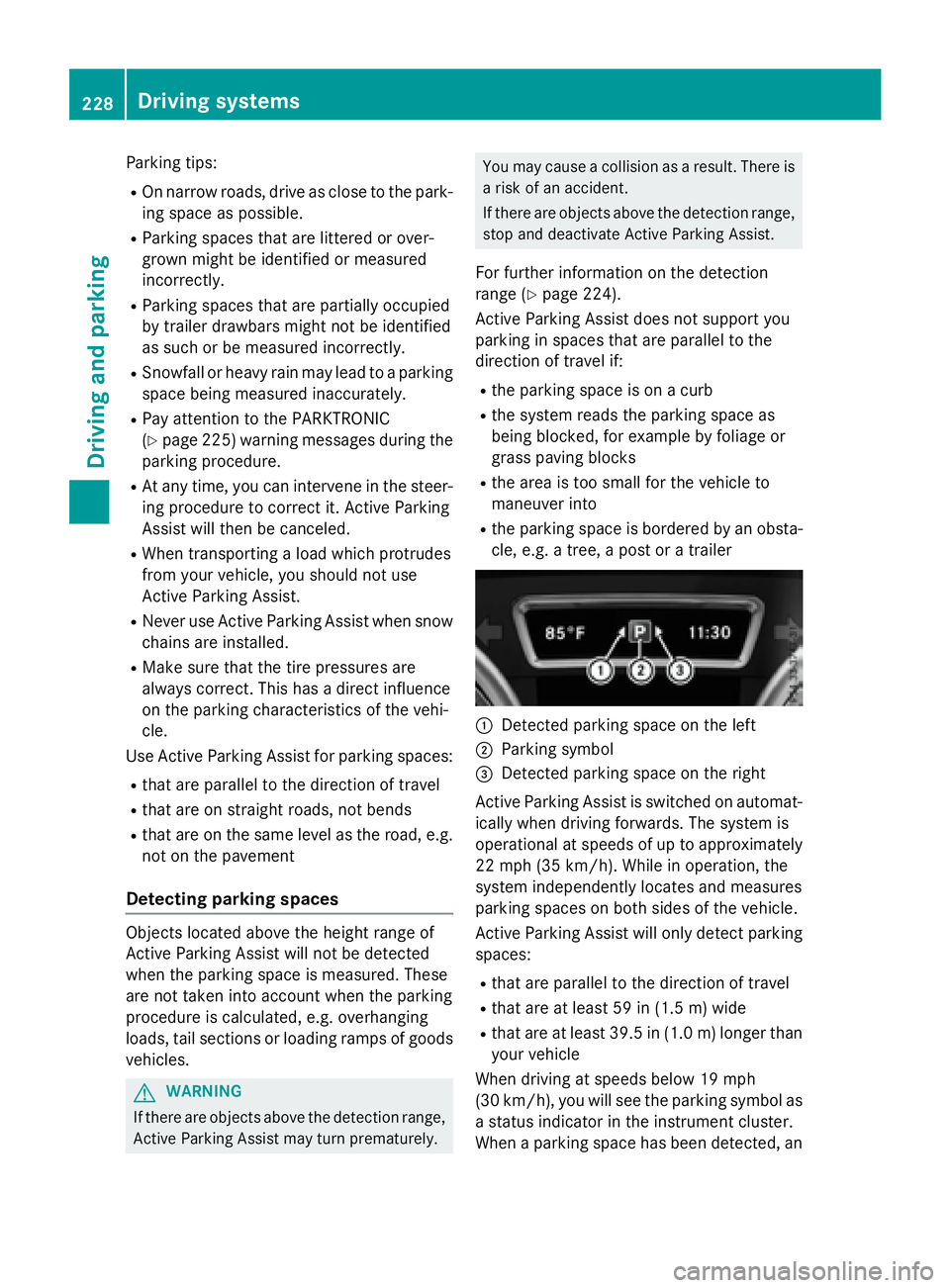
Parking tips: R
On narrow roads, drive as close to the park-
ing space as possible. R
Parking spaces that are littered or over-
grown might be identified or measured
incorrectly. R
Parking spaces that are partially occupied
by trailer drawbars might not be identified
as such or be measured incorrectly. R
Snowfall or heavy rain may lead to a parking
space being measured inaccurately. R
Pay attention to the PARKTRONIC
( Y
page 225) warning messages during the
parking procedure. R
At any time, you can intervene in the steer-
ing procedure to correct it. Active Parking
Assist will then be canceled. R
When transporting a load which protrudes
from your vehicle, you should not use
Active Parking Assist. R
Never use Active Parking Assist when snow
chains are installed. R
Make sure that the tire pressures are
always correct. This has a direct influence
on the parking characteristics of the vehi-
cle.
Use Active Parking Assist for parking spaces: R
that are parallel to the direction of travel R
that are on straight roads, not bends R
that are on the same level as the road, e.g.
not on the pavement
Detecting parking spaces
Objects located above the height range of
Active Parking Assist will not be detected
when the parking space is measured. These
are not taken into account when the parking
procedure is calculated, e.g. overhanging
loads, tail sections or loading ramps of goods
vehicles.
G WARNING
If there are objects above the detection range,
Active Parking Assist may turn prematurely. You may cause a collision as a result. There is
a risk of an accident.
If there are objects above the detection range,
stop and deactivate Active Parking Assist.
For further information on the detection
range ( Y
page 224).
Active Parking Assist does not support you
parking in spaces that are parallel to the
direction of travel if: R
the parking space is on a curb R
the system reads the parking space as
being blocked, for example by foliage or
grass paving blocks R
the area is too small for the vehicle to
maneuver into R
the parking space is bordered by an obsta-
cle, e.g. a tree, a post or a trailer
�C
Detected parking space on the left �D
Parking symbol �
Page 259 of 462
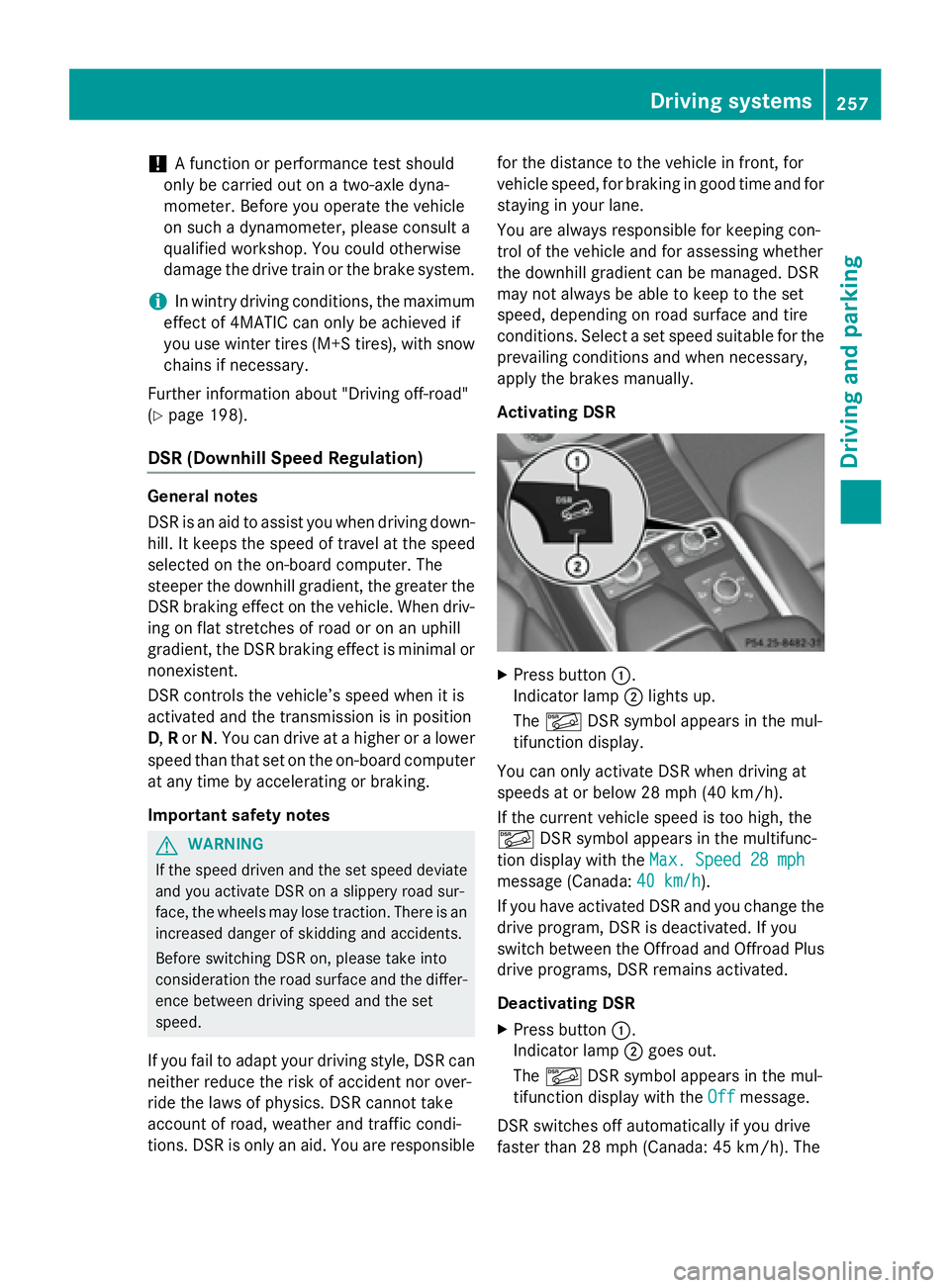
! A function or performance test should
only be carried out on a two-axle dyna-
mometer. Before you operate the vehicle
on such a dynamometer, please consult a
qualified workshop. You could otherwise
damage the drive train or the brake system.
i In wintry driving conditions, the maximum
effect of 4MATIC can only be achieved if
you use winter tires (M +S tires), with snow
chains if necessary.
Further information about "Driving off-road"
( Y
page 198).
DSR (Downhill Speed Regulation) General notes
DSR is an aid to assist you when driving down-
hill. It keeps the speed of travel at the speed
selected on the on-board computer. The
steeper the downhill gradient, the greater the
DSR braking effect on the vehicle. When driv-
ing on flat stretches of road or on an uphill
gradient, the DSR braking effect is minimal or
nonexistent.
DSR controls the vehicle’s speed when it is
activated and the transmission is in position
D , R or N . You can drive at a higher or a lower
speed than that set on the on-board computer
at any time by accelerating or braking.
Important safety notes
G WARNING
If the speed driven and the set speed deviate
and you activate DSR on a slippery road sur-
face, the wheels may lose traction. There is an
increased danger of skidding and accidents.
Before switching DSR on, please take into
consideration the road surface and the differ-
ence between driving speed and the set
speed.
If you fail to adapt your driving style, DSR can
neither reduce the risk of accident nor over-
ride the laws of physics. DSR cannot take
account of road, weather and traffic condi-
tions. DSR is only an aid. You are responsible for the distance to the vehicle in front, for
vehicle speed, for braking in good time and for
staying in your lane.
You are always responsible for keeping con-
trol of the vehicle and for assessing whether
the downhill gradient can be managed. DSR
may not always be able to keep to the set
speed, depending on road surface and tire
conditions. Select a set speed suitable for the
prevailing conditions and when necessary,
apply the brakes manually.
Activating DSR
X
Press button �C .
Indicator lamp �D lights up.
The �
Page 262 of 462
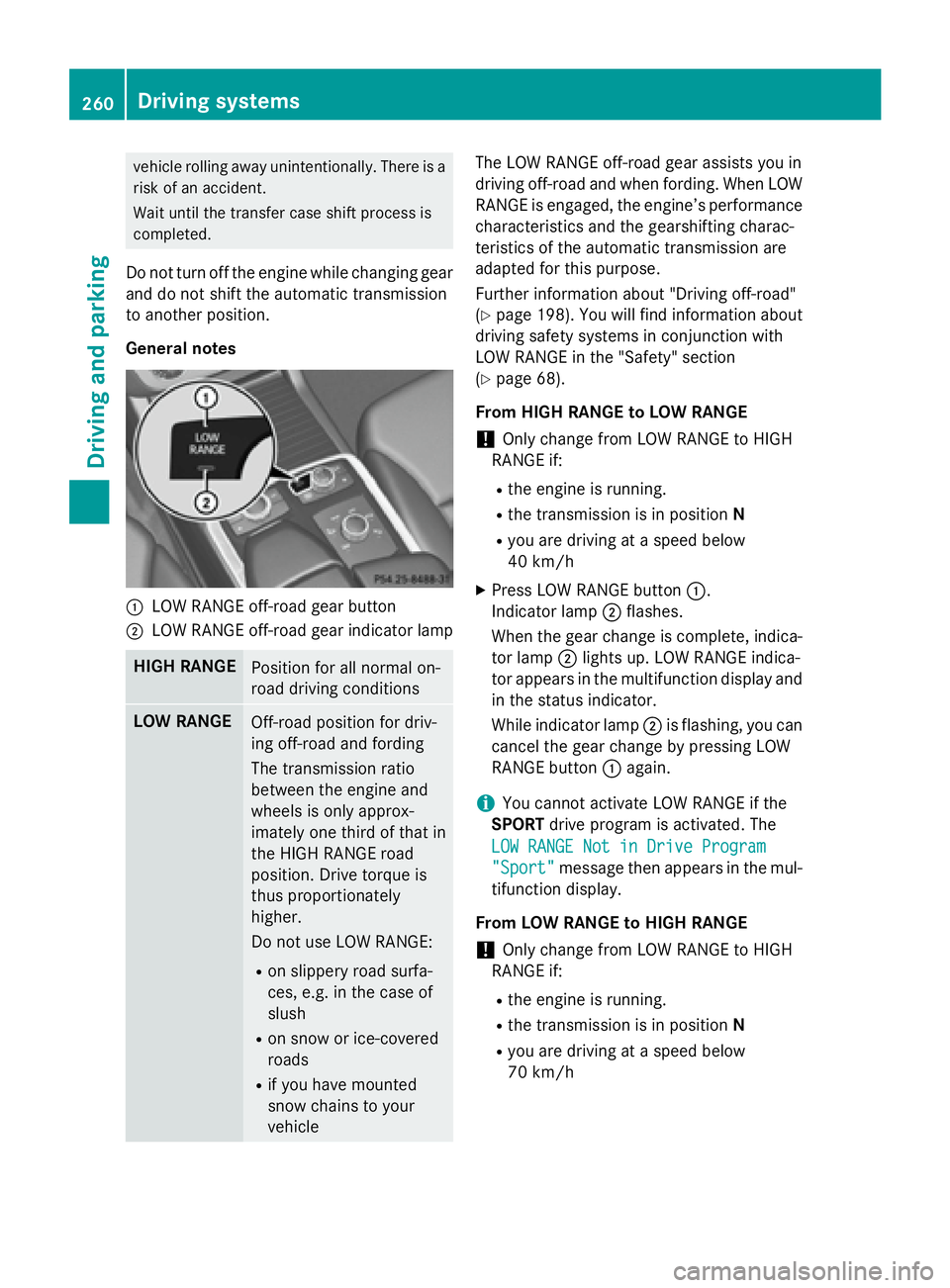
vehicle rolling away unintentionally. There is a
risk of an accident.
Wait until the transfer case shift process is
completed.
Do not turn off the engine while changing gear
and do not shift the automatic transmission
to another position.
General notes
�C
LOW RANGE off-road gear button�D
LOW RANGE off-road gear indicator lamp
HIGH RANGE
Position for all normal on-
road driving conditions
LOW RANGE
Off-road position for driv-
ing off-road and fording
The transmission ratio
between the engine and
wheels is only approx-
imately one third of that in
the HIGH RANGE road
position. Drive torque is
thus proportionately
higher.
Do not use LOW RANGE: R
on slippery road surfa-
ces, e.g. in the case of
slush R
on snow or ice-covered
roads R
if you have mounted
snow chains to your
vehicle The LOW RANGE off-road gear assists you in
driving off-road and when fording. When LOW
RANGE is engaged, the engine’s performance
characteristics and the gearshifting charac-
teristics of the automatic transmission are
adapted for this purpose.
Further information about "Driving off-road"
( Y
page 198). You will find information about
driving safety systems in conjunction with
LOW RANGE in the "Safety" section
( Y
page 68).
From HIGH RANGE to LOW RANGE
! Only change from LOW RANGE to HIGH
RANGE if: R
the engine is running. R
the transmission is in position NR
you are driving at a speed below
40 km/h X
Press LOW RANGE button �C .
Indicator lamp �D flashes.
When the gear change is complete, indica-
tor lamp �D lights up. LOW RANGE indica-
tor appears in the multifunction display and
in the status indicator.
While indicator lamp �D is flashing, you can
cancel the gear change by pressing LOW
RANGE button �C again.
i You cannot activate LOW RANGE if the
SPORT drive program is activated. The
LOW RANGE Not in Drive Program
"Sport" message then appears in the mul-
tifunction display.
From LOW RANGE to HIGH RANGE
! Only change from LOW RANGE to HIGH
RANGE if: R
the engine is running. R
the transmission is in position NR
you are driving at a speed below
70 km/h260
Driving systems
Driving and parking
Page 409 of 462
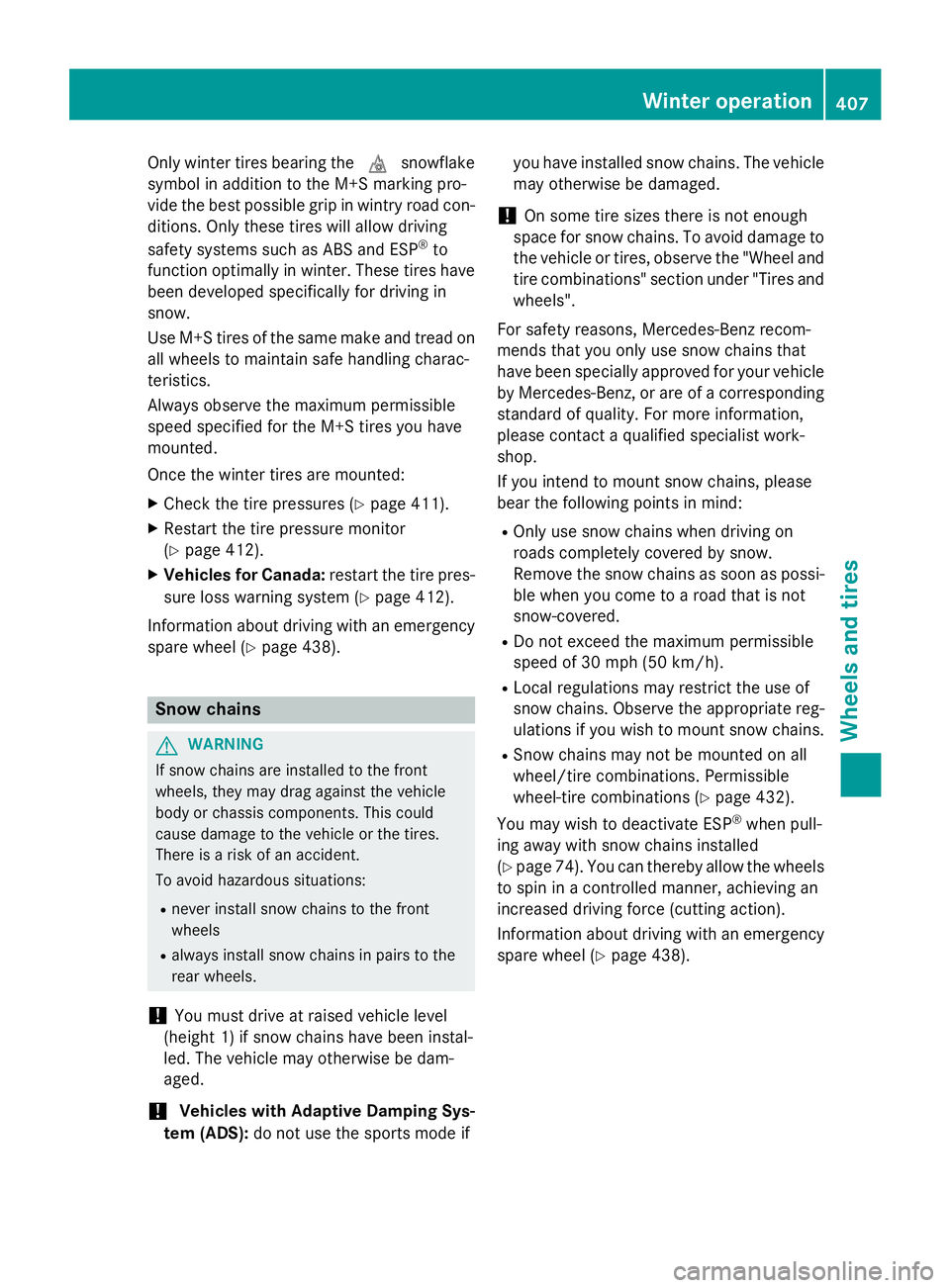
Only winter tires bearing the �M snowflake
symbol in addition to the M+S marking pro-
vide the best possible grip in wintry road con-
ditions. Only these tires will allow driving
safety systems such as ABS and ESP ®
to
function optimally in winter. These tires have
been developed specifically for driving in
snow.
Use M+S tires of the same make and tread on
all wheels to maintain safe handling charac-
teristics.
Always observe the maximum permissible
speed specified for the M+S tires you have
mounted.
Once the winter tires are mounted: X
Check the tire pressures ( Y
page 411).X
Restart the tire pressure monitor
( Y
page 412). X
Vehicles for Canada: restart the tire pres-
sure loss warning system ( Y
page 412).
Information about driving with an emergency
spare wheel ( Y
page 438).
Snow chains
G WARNING
If snow chains are installed to the front
wheels, they may drag against the vehicle
body or chassis components. This could
cause damage to the vehicle or the tires.
There is a risk of an accident.
To avoid hazardous situations: R
never install snow chains to the front
wheels R
always install snow chains in pairs to the
rear wheels.
! You must drive at raised vehicle level
(height 1) if snow chains have been instal-
led. The vehicle may otherwise be dam-
aged.
! Vehicles with Adaptive Damping Sys-
tem (ADS): do not use the sports mode if you have installed snow chains. The vehicle
may otherwise be damaged.
! On some tire sizes there is not enough
space for snow chains. To avoid damage to
the vehicle or tires, observe the "Wheel and
tire combinations" section under "Tires and
wheels".
For safety reasons, Mercedes-Benz recom-
mends that you only use snow chains that
have been specially approved for your vehicle
by Mercedes-Benz, or are of a corresponding
standard of quality. For more information,
please contact a qualified specialist work-
shop.
If you intend to mount snow chains, please
bear the following points in mind: R
Only use snow chains when driving on
roads completely covered by snow.
Remove the snow chains as soon as possi-
ble when you come to a road that is not
snow-covered. R
Do not exceed the maximum permissible
speed of 30 mph (50 km/h). R
Local regulations may restrict the use of
snow chains. Observe the appropriate reg-
ulations if you wish to mount snow chains. R
Snow chains may not be mounted on all
wheel/tire combinations. Permissible
wheel-tire combinations ( Y
page 432).
You may wish to deactivate ESP ®
when pull-
ing away with snow chains installed
( Y
page 74). You can thereby allow the wheels
to spin in a controlled manner, achieving an
increased driving force (cutting action).
Information about driving with an emergency
spare wheel ( Y
page 438).Winter operation 407
Wheels and tires Z